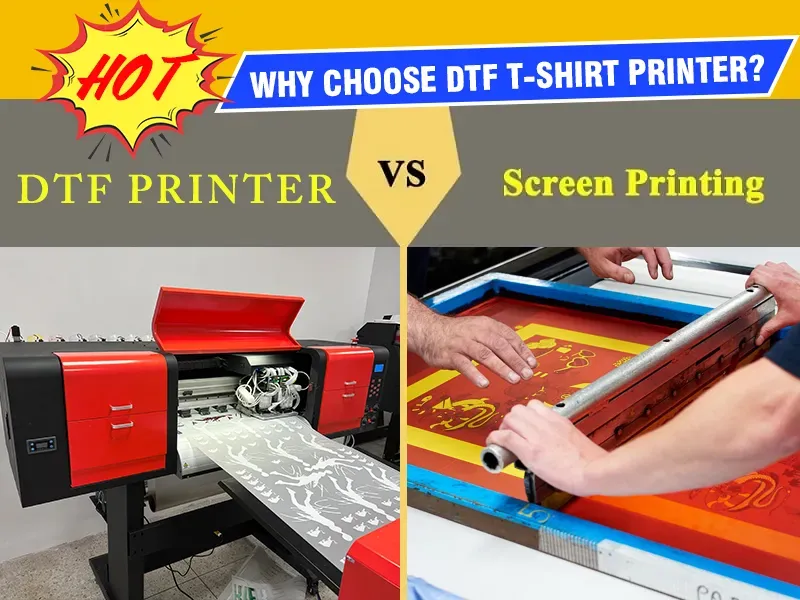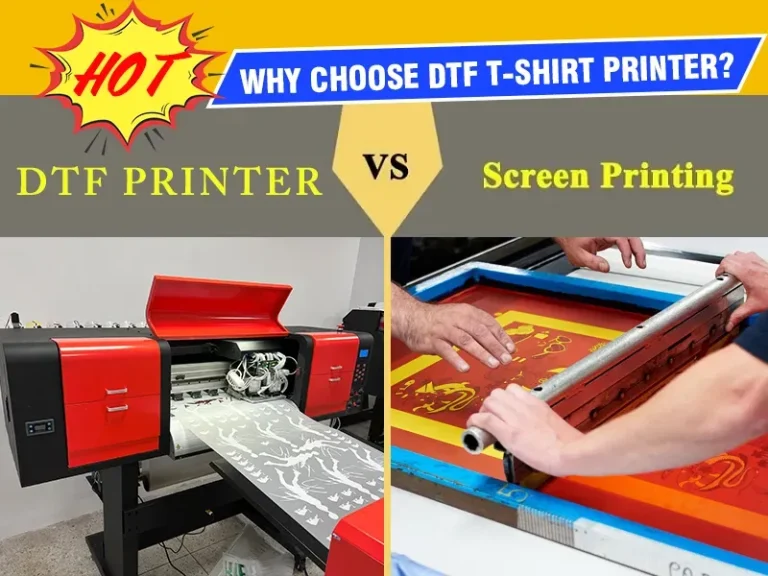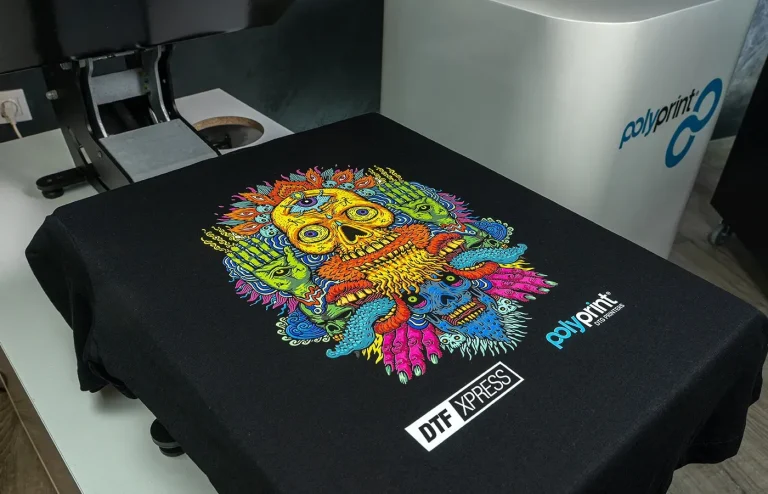DTF vs. Screen Printing: Which is Better for Your Project?
In the world of custom garment printing, the choice between DTF vs. Screen Printing can significantly impact the quality and efficiency of your projects. This comparison highlights the strengths and weaknesses of each technique, as businesses strive to determine which printing method is better suited for their specific needs. DTF printing advantages, such as vibrant colors and quick turnaround times, often make it appealing for smaller, intricate designs, while screen printing benefits shine in large-volume orders requiring durability and cost-effectiveness. By exploring the details of each method, including their environmental impacts, you can make a more informed decision. Ultimately, understanding these two popular techniques enhances your ability to create stunning apparel that meets your customers’ expectations.
When evaluating the methods of garment decoration, the Direct-to-Film (DTF) technique stands in contrast to the classic approach of screen printing. Known for its ability to deliver detailed and vibrant designs, DTF brings modern technology into the realm of fabric printing, enticing businesses looking for efficiency and flexibility. On the other hand, the traditional method of screen printing remains a favorite for producing bulk designs at lower costs while ensuring robust color accuracy and longevity. This article aims to provide a comprehensive DTF vs. screen printing comparison, helping you to assess which option will serve your project best. By examining various factors such as setup costs, turnaround times, and design flexibility, you’ll gain valuable insights into the ideal choices for your custom printing needs.
Understanding the Basics of DTF Printing
Direct-to-Film (DTF) printing represents a revolutionary advancement in the world of custom garment printing. Unlike traditional methods, DTF allows for designs to be applied directly onto a special film, which is then transferred to the fabric with heat. This process eliminates many of the constraints associated with other printing techniques, providing a unique synergy of versatility and detail. With DTF, designers are not held back by the limitations that come with preparing screens or mixing inks, making it an appealing option for creative projects that require a high level of complexity.
The significant rise in the adoption of DTF printing can be attributed to its vibrant output and strong color accuracy, which are essential for eye-catching designs. Businesses looking to create detailed artwork benefit immensely from this technology, as DTF printing offers a reliable way to produce custom pieces with intricate graphics and varied color palettes. Moreover, the ease of adjusting designs makes it suitable for small runs, where flexibility is advantageous.
Benefits of DTF Printing for Custom Garments
One of the most compelling advantages of DTF printing is its ability to produce vibrant colors and complex designs. This method excels in rendering intricate artwork, making it ideal for products that demand high-quality imagery and detailed visuals. This capability positions DTF printing as a preferred choice for companies specializing in custom garment printing, catering to those with a focus on fashion and unique prints. For brands that rely on their designs to stand out, the vivid outputs of DTF technology can create a significant marketing edge.
Additionally, DTF printing streamlines the production process, offering quick turnaround times without sacrificing quality. For businesses needing adaptations or rapid responses, DTF allows for efficient work on multiple orders simultaneously. This ability to reduce lead times is invaluable in today’s fast-paced market, where customer satisfaction is linked directly to prompt service. Coupled with less environmental waste compared to traditional methods, DTF printing represents a forward-thinking approach to garment decoration.
Exploring the Strengths of Screen Printing
Screen printing, a tried-and-true technique in the fabric printing industry, boasts a plethora of benefits that make it a staple for many businesses. One of the foremost advantages is its cost-effectiveness for large-scale operations. The economics of scale become apparent as the production volume increases; the cost per item drastically decreases, providing an attractive option for orders that require multiple pieces. This makes screen printing the method of choice for organizations looking to capitalize on bulk production.
Moreover, screen printing shines in its ability to create durable and long-lasting prints. The thick layer of ink used in this process ensures that designs can withstand the rigors of everyday wear and frequent washing, making it an ideal solution for items like uniforms and promotional merchandise that are expected to endure. In addition, businesses benefit from the color consistency that screen printing delivers across numerous items in a single production run, fostering brand identity through uniformity.
Key Advantages of Screen Printing for Bulk Production
For large orders, the scalability of screen printing provides a reliable solution for businesses that need to print substantial quantities without compromising on quality. As the number of pieces increases, initial setup costs, although higher than that of DTF, are diluted over the entire batch, resulting in a lower overall price point. This efficiency is a significant motivator for companies engaged in mass production, as it allows for a greater profit margin while appealing to budget-conscious clients.
Furthermore, the durability of screen-printed designs is unmatched, making it particularly appealing for industries requiring high durability, such as sports and workwear. The thickness of the ink layer can withstand the stresses of daily use much better than many other methods, which can prove prone to fading or cracking over time. This longevity provides an added value for businesses seeking to ensure the reliability of their merchandise, promising customers quality that lasts.
DTF vs. Screen Printing: Comparing Techniques
When diving into the specifics of DTF vs. screen printing, it’s crucial to evaluate the core differences that define each method. DTF printing excels in producing vibrant, intricate designs quickly, making it highly suitable for short runs and custom orders. On the other hand, screen printing stands out for cost efficiency in larger production volumes, which is essential for businesses that need to meet high demand while keeping prices competitive. The choice often boils down to the specific requirements of a project, such as design complexity, quantity, and immediate customer needs.
Moreover, while DTF printing offers flexibility and rapid turnaround, screen printing guarantees durability and consistency. For instance, if a business is looking to print a large batch of promotional t-shirts, screen printing might be the more logical approach. Conversely, a fashion brand aiming to produce limited-edition clothing with unique designs might find DTF’s capabilities more aligned with their objectives. Understanding these distinctions can empower businesses to choose the best printing method that matches their project goals.
Determining the Best Method for Your Needs
Selecting the appropriate printing method boils down to understanding your specific needs as well as the nature of your project. If you are working on a small batch of garments featuring detailed designs or require fast delivery, DTF printing emerges as the clear winner, thanks to its speed and adaptability. This is particularly beneficial for those in the fast fashion industry or businesses that thrive on seasonal collections.
In contrast, if your project calls for a large quantity of items where budget constraints are paramount, screen printing should be your go-to option. Its cost-effectiveness in high volumes ensures that businesses do not overspend while still achieving excellent quality. The choice between DTF and screen printing isn’t merely based on technology but rather on aligning the printing method with broader business goals and customer expectations.
Frequently Asked Questions
What are the advantages of DTF printing compared to screen printing?
DTF printing offers several advantages including vibrant colors and the ability to reproduce intricate designs with high detail. It’s ideal for projects featuring photographic images or gradient colors. Moreover, DTF allows for quicker turnaround times and less setup waste, making it highly efficient for custom garment printing.
How does screen printing benefit large-scale production over DTF printing?
Screen printing is often more cost-effective for large runs due to its low production costs per item. The method excels in durability, ensuring printed designs withstand repeated washes, making it ideal for uniforms and promotional items. Additionally, screen printing delivers consistent color quality across large batches.
Which printing method is better for custom designs, DTF or screen printing?
For custom designs that require high detail and rapid production, DTF printing is generally preferred. It accommodates various designs without extensive setup and can quickly adapt to new artwork, making it an excellent choice for small batch orders.
What should I consider when comparing DTF vs. screen printing for my project?
When choosing between DTF vs. screen printing, consider factors like project size, design complexity, budget, and durability needs. DTF is best for smaller projects with intricate designs, while screen printing is advantageous for large orders where cost-effectiveness and durability are crucial.
Is DTF printing environmentally friendly compared to screen printing?
DTF printing tends to be more environmentally friendly than screen printing as it generates less waste during the setup process. This sustainability aspect appeals to businesses looking to align their practices with eco-conscious consumer demands.
Can I achieve the same level of durability with DTF printing as with screen printing?
While DTF printing provides a sturdy finish, screen printing is typically more durable and withstands frequent washing better. For projects necessitating longevity, screen printing is often the preferred method due to its robust nature.
| Feature | DTF Printing | Screen Printing |
|---|---|---|
| Process | Prints design onto film and heat presses onto garment. | Involves pushing ink through a mesh stencil onto the garment; separate stencils for each color. |
| Advantages | 1. Vibrant colors and complex designs. 2. Quick turnaround, ideal for small batches. 3. Greater flexibility in design changes. 4. Less waste, environmentally friendly. |
1. Cost-effective for large runs. 2. Durable prints that withstand repeated wash and wear. 3. Consistent quality across large orders. |
| Disadvantages | 1. Less cost-effective for large volumes. 2. Durability may vary. |
1. Longer setup time with higher initial costs. 2. Less flexibility in design changes since screens must be remade. |
| Best For | Small runs and detailed designs requiring quick production. | Large volume orders prioritizing durability and cost-per-item. |
Summary
When considering DTF vs. Screen Printing, it’s essential to recognize that the best option largely depends on your unique project requirements. DTF printing stands out for small, intricate designs with a quick turnaround, making it an excellent choice for customization. On the other hand, screen printing is unparalleled for large batches where durability and cost-effectiveness are prioritized. Both methods offer distinct advantages and potential drawbacks, and understanding these can significantly influence your decision, ultimately leading to improved outcomes for your printing needs.




